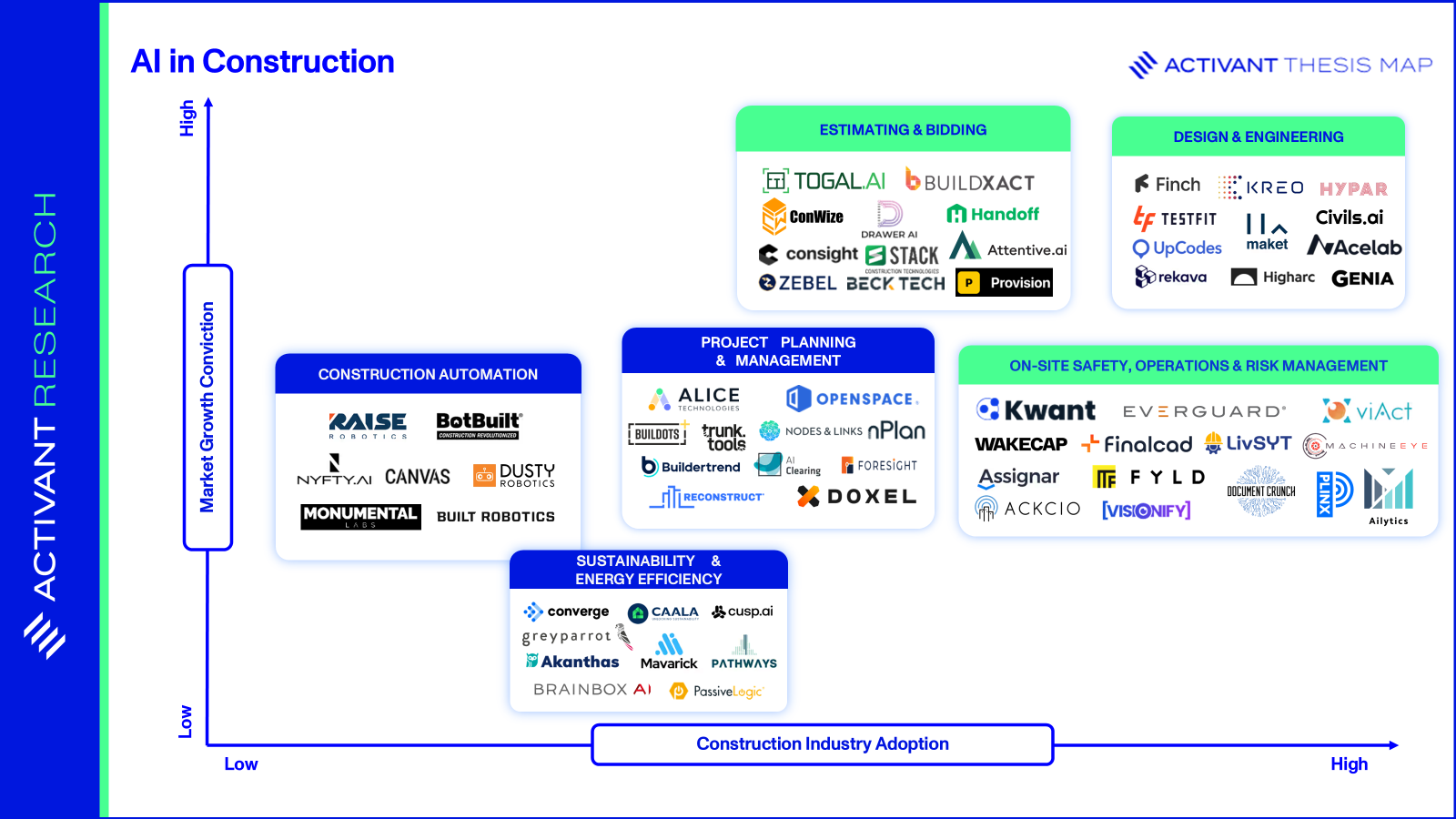- Activant's Greene Street Observer
- Posts
- The Blueprint for a Smarter Future
The Blueprint for a Smarter Future
AI's Role in Construction

Introduction
Artificial intelligence won’t build your house tomorrow, but it may already be designing it, estimating the budget and optimizing your jobsite. Long perceived as a digital laggard, the construction industry is slowly shifting gears. Traditionally reactive and slow to adopt new technologies, the industry is now increasingly exploring AI not just as a tool, but as a transformative collaborator.
AI has the potential to fundamentally shift how the sector operates but the path remains long, fragmented, and full of resistance. In RICS’s AI in Construction 2025 survey, ~45% of respondents said their organisations don’t use AI, 34% are only in early pilots, and fewer than 12% regularly use it in a specific process. Still, the tide is turning: the report found that AI has emerged as the leading construction technology for increased investment, with 56% of respondents planning to allocate more funds to it than the previous year.
The construction industry is cautiously optimistic about AI. While there appears to be excitement around productivity and safety gains, adoption is slowed by legacy systems, fragmented workflows, and a lack of AI literacy among field teams. Construction’s slow digitization leaves data unstructured, keeping processes manual and AI underutilized. This creates a classic paradox: AI depends on digitization to work, yet digitization often stalls without clear AI-driven value. Risk aversion deepens the gap as contractors are hesitant to adopt AI tools that aren’t nearly flawless, especially when errors could lead to catastrophic outcomes like structural failures.
As part of our ongoing research within the construction space, we’ve mapped out where AI is taking hold and where gaps persist. Construction Technology (ConTech) startups, in particular, offer an easier and simpler route for construction players to begin implementing AI solutions. While adoption is far from uniform, we're starting to see meaningful traction in specific functions where efficiency gains are undeniable.
Laying The Groundwork: From CAD to Cognitive Agents
AI-powered systems for construction have been evolving over the last two decades. The roots trace back to the 1960s, when Computer-Aided Design (CAD) first made it possible to digitally draft and optimize construction plans. In the following decades, Computer-Aided Manufacturing (CAM) and Computer Numerical Control (CNC) machines began streamlining the production of building components.
By the early 2000s, machine learning emerged as a new frontier. Initially, AI's role was largely confined to predictive analytics, primarily applied to asset maintenance and project scheduling. Construction firms began leveraging machine learning models to forecast equipment failures, identify cost overruns, and optimize workforce deployment. These early use cases were often siloed, but they laid the groundwork for a broader shift in mindset across the industry.
A turning point came in the 2010s, as Building Information Modeling (BIM) became more data-rich and accessible computing power unlocked new AI capabilities. While BIM isn’t an AI technology, it provided the structured data needed to fuel machine learning models. Robotic automation then began appearing on construction sites: Built Robotics introduced autonomous excavation and Fastbrick Robotics developed systems for robotic bricklaying, proof that AI could now physically shape the built environment.
In the late 2010s and early 2020s, the rise of computer vision and wearable tech enabled proactive safety measures. Construction companies could now use AI to predict and prevent hazards in real time, marking a shift from reactive to predictive safety cultures and helping firms mitigate one of the most persistent risks in construction.
In this report, we look at how companies are currently securing the last mile, examine how outdated infrastructure, non-human identities and non-standard apps are leaving cracks for attackers to exploit, and consider the start-ups that are emerging to solve these problems.
The timeline below highlights the various technological changes that we believe have helped pave the way for the introduction of AI within construction.

Today, AI supports every phase of construction, from generative design that optimizes cost and efficiency, to bidding platforms that streamline procurement, and digital twins that simulate projects before breaking ground. Even 3D printing is evolving with AI-guided modular and nuclear components. Experts see the greatest impact in pre-construction, where design, estimating, and bidding can be largely automated.
Despite this progress, widespread adoption remains uneven. Many firms still struggle with outdated systems, fragmented data environments, and a workforce in need of digital upskilling. The opportunities are vast, but the ability to fully implement AI solutions is out of reach for many small and mid-sized players in the construction space.
Current State of Play
Experts describe construction as a “slow-moving business”, where technology trends can take 15 to 20 years to take hold. Despite its potential, AI adoption in construction remains limited. A 2025 MIT Sloan study revealed that 65% of construction leaders reported their companies are not yet using AI or predictive analytics for planning or execution.
